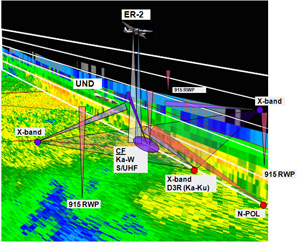The NASA Global Precipitation Measurement Mission (GPM) Ground Validation (GV) program, as a member of the broader NASA Precipitation Measurement Mission, is providing ground and airborne precipitation datasets supporting physical validation of satellite-based precipitation retrieval algorithms.
The requisite GV measurements include multi-frequency dual-polarimetric radar (S, C, X, Ka/Ku and W bands), airborne microphysical probe, radar and radiometer observations (e.g., provision of a GPM core satellite "proxy"), and ground-based disdrometer and raingauge network observations as a core instrument and measurement complement.

The GPM-GV instrument suite was deployed in numerous field campaigns in several different precipitation regimes. In addition to the ones listed below, these campaigns and regimes also include the NOAA Hydrometeorological Testbed-Southeast campaign (HMT-SE; North Carolina, Summer 2014) as well as international partner-lead field efforts such as the GPM-Brazil CHUVA campaign (2009-2013).
The associated GV measurements and observational strategies seek to advance our physical understanding of precipitation processes and assure consistency between this understanding and the representation of those physical processes in NASA GPM retrieval algorithms. The GPM Ground Validation program also supports a Validation Network (VN) that currently matches TRMM Microwave Imager (TMI) rain rate and Precipitation Radar (PR) reflectivity and rain rate to ground‑based meteorological radars.
Additional GPM-GV datasets are available here, including APU, JW, C3VP, TWP-ICE, and 2DVD datasets.






